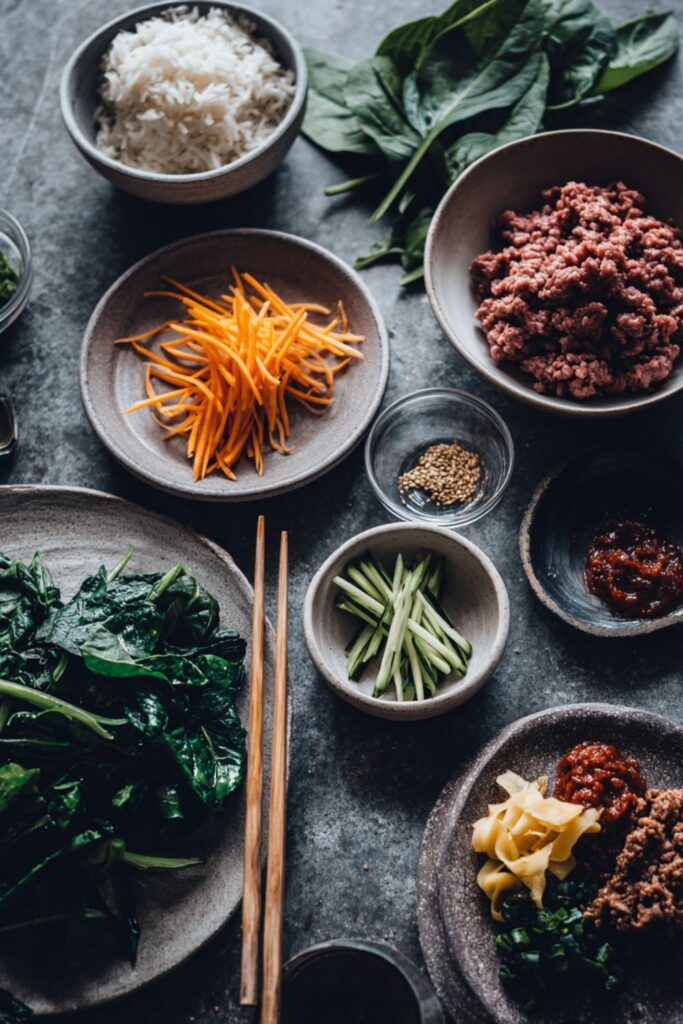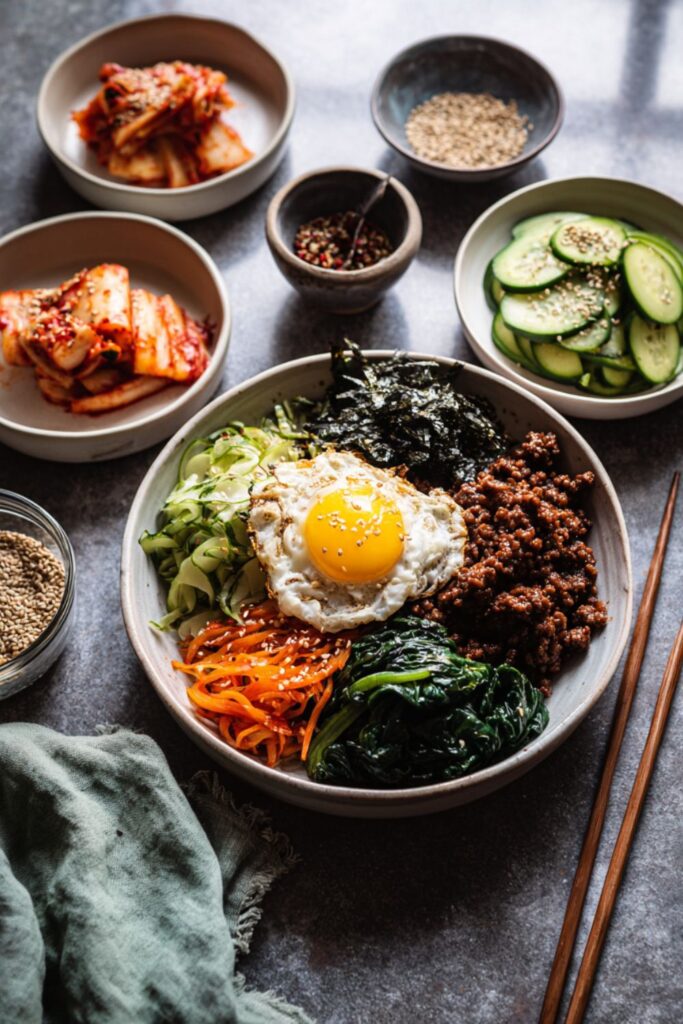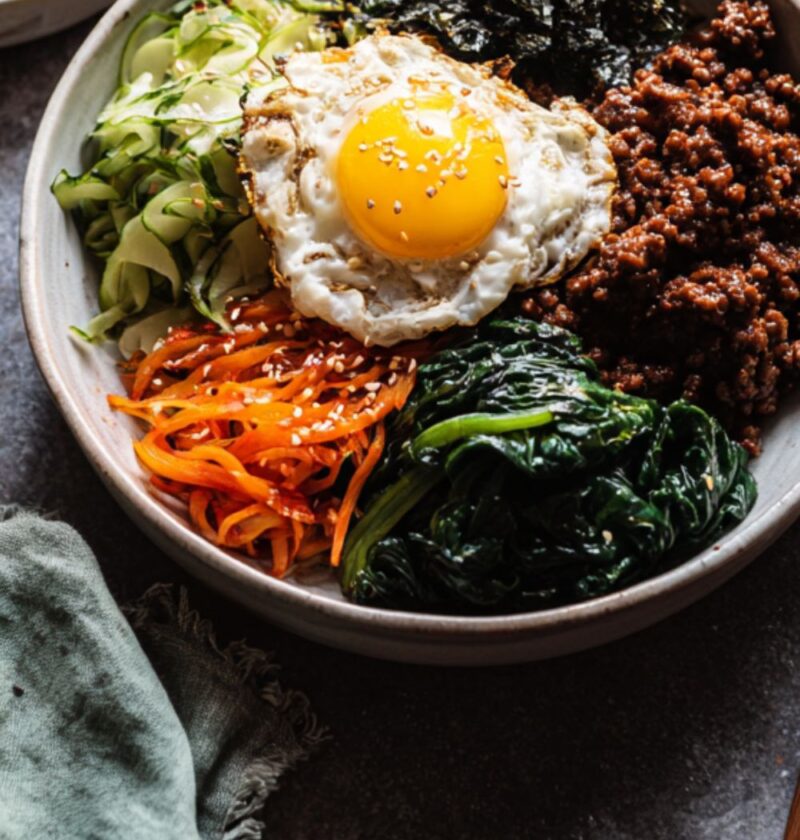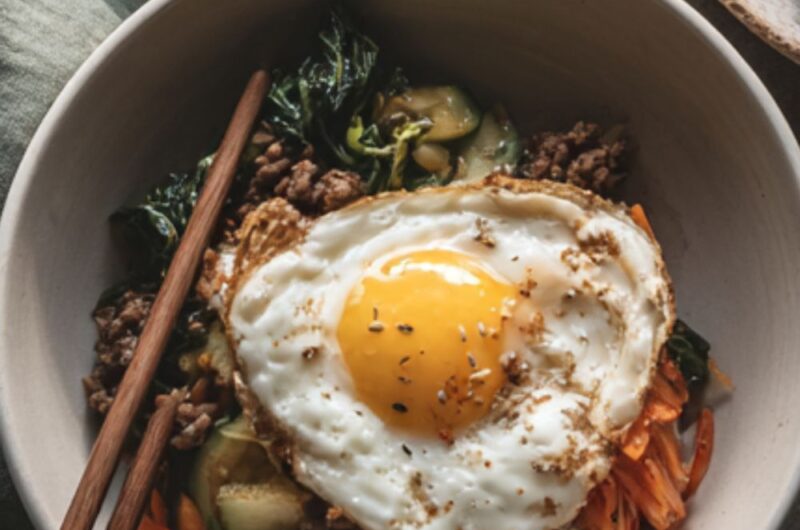This hearty Low FODMAP Bibimbap is made with savory ground beef, gochugaru, gluten-free tamari, fresh spinach, and carrots. The result is a sweet, spicy, and savory Korean rice bowl that is a complete, satisfying meal. This recipe is perfect for a flavorful weeknight dinner that is gentle on your gut and makes 4 large servings.
Jump to RecipeLow FODMAP Bibimbap Ingredients
Bibimbap Sauce
- 2 tablespoons gochugaru (Korean chili powder)
- 1 1/2 tablespoons gluten-free tamari
- 1 1/2 tablespoons pure maple syrup
- 2 teaspoons rice vinegar
- 2 teaspoons gluten-free miso paste
- 1 teaspoon garlic-infused olive oil
- 1 teaspoon sesame oil
Bibimbap Ground Beef
- 1 tablespoon garlic-infused olive oil
- 1 pound lean ground beef (90%/10%)
- 2 tablespoons gluten-free tamari
- 2 tablespoons pure maple syrup
- 1 tablespoon gochugaru (optional, for extra flavor)
- 1 teaspoon minced ginger
- Black pepper to taste
- 1/4 cup chopped green onion tips (green parts only)
- 1 teaspoon sesame oil
- 1 teaspoon sesame seeds
Optional Toppings & Accompaniment
- 1 zucchini, cut into thin matchsticks
- 1 medium carrot, julienned or shredded
- 10 ounces baby spinach
- 4 fried eggs
- Garlic-infused olive oil (for sautéing/frying)
- Fine sea salt
- Gluten-free tamari (for spinach)
- Sesame oil (for spinach)
For Serving
- 4 cups cooked rice
- Roasted seaweed, cut into strips (optional)
- Additional sesame seeds (optional)

How To Make Low FODMAP Bibimbap
- Mix the Bibimbap sauce: In a small bowl, add all the sauce ingredients. Whisk or mix with a fork until everything is well combined. If you want a thinner sauce, add 1 teaspoon of water at a time until it reaches your desired consistency.
- Sauté the vegetables: Heat a small amount of garlic-infused oil in a large wok or frying pan over medium-high heat. Add the carrots and sauté for 3-4 minutes until tender-crisp. Remove them to a plate and toss with a light pinch of salt.
- Cook the other toppings: Add more garlic oil to the pan if needed. Sauté the zucchini for 1-2 minutes until just tender. Set it aside. Add the baby spinach to the hot pan and sauté until wilted. Place the spinach in a small bowl and toss it with a dash of gluten-free tamari and sesame oil.
- Fry the eggs: In the same pan, adding more oil if needed, fry 4 eggs to your liking. Sunny-side up is a traditional choice.
- Cook the ground beef: Heat 1 tablespoon of garlic-infused oil in the wok on high heat. Add the ground beef and let one side cook and brown for 2-3 minutes without moving it.
- Season the beef: Add the gluten-free tamari, maple syrup, optional gochugaru, minced ginger, and black pepper. Break up the ground beef with a spoon and stir-fry until the beef is almost cooked through.
- Finish the beef: During the last minute of cooking, add the chopped green onion tips. Turn off the heat and stir in the sesame oil and sesame seeds.
- Assemble the bowls: Divide the cooked rice among four bowls. Arrange the cooked ground beef, sautéed carrots, zucchini, spinach, and a fried egg on top of the rice. Drizzle with your desired amount of bibimbap sauce and garnish with roasted seaweed and extra sesame seeds, if using.
Recipe Tips
- Use Only Green Onion Tips: To keep this recipe low FODMAP, only use the dark green parts of the green onions. The white and light green bulbs are high in fructans (a FODMAP) and can cause digestive symptoms.
- Garlic-Infused Oil is Key: This oil provides a safe garlic flavor. The FODMAPs in garlic are water-soluble, not oil-soluble. This means the flavor infuses the oil, but the gut-irritating fructans stay behind.
- Get a Good Brown on the Beef: When you first add the beef to the hot pan, don’t stir it. Letting it sit for 2-3 minutes creates a dark, flavorful crust (called the Maillard reaction), which adds much more savory depth to the final dish.
- Prepare Toppings First: This recipe moves very quickly. Have all your vegetables chopped, the sauce mixed, and your ingredients measured before you start cooking. This makes the assembly process smooth and prevents overcooking.
What To Serve Bibimbap
This Low FODMAP Bibimbap is a complete meal in one bowl. It already has your protein, carbohydrates, and plenty of vegetables. You don’t need much else! However, if you want to add a small, traditional side, you could serve it with a gut-friendly quick-pickled cucumber salad (which mimics kimchi) or a simple bowl of clear, low-sodium beef or chicken broth to sip alongside.

How To Store Bibimbap Leftovers
- Refrigerate: The best way to store leftovers is to keep all the components separate. Store the cooked beef, rice, and each vegetable topping in its own airtight container in the refrigerator for up to 3 days. Store the sauce in a jar.
- Reheat: Reheat the rice, beef, and vegetables in the microwave or in a pan. It is best to cook a fresh egg right before serving. Assemble the bowl just like you did the first time. Freeze: The cooked ground beef mixture freezes very well in an airtight container for up to 3 months. The vegetables and rice do not freeze well and can become mushy.
Low FODMAP Bibimbap Nutrition Facts
- Calories: 710 kcal
- Total Fat: 30g
- Saturated Fat: 9g
- Cholesterol: 250mg
- Sodium: 1050mg
- Total Carbohydrate: 75g
- Dietary Fiber: 5g
- Sugars: 12g
- Protein: 35g
Frequently Asked Questions
- What is gochugaru and is it low FODMAP? Gochugaru is a coarse Korean chili powder. Yes, according to Monash University (which tests for FODMAPs), it is low FODMAP and safe to enjoy. It has a smoky, sweet, and moderately spicy flavor.
- Can I use gochujang instead of the sauce ingredients? No, traditional gochujang (Korean chili paste) is not low FODMAP. It is usually made with garlic, onion, and high-fructose corn syrup or other sweeteners that are high in FODMAPs. This recipe’s sauce is designed to recreate that flavor safely.
- Can I use a different meat? Yes, this would be delicious with ground turkey or ground chicken. You could also make it vegetarian by swapping the beef with crumbled firm tofu.
- What other low FODMAP vegetables can I add? This dish is very versatile! You could add other safe-serve vegetables like bean sprouts (up to 1 cup), shredded red bell pepper (up to 1/3 cup), or sautéed oyster mushrooms.
Low FODMAP Bibimbap Recipe
Course: Lunch, MainCuisine: Korean4
servings20
minutes25
minutes710
kcalThis hearty Low FODMAP Bibimbap is a gut-friendly version of the classic Korean rice bowl. It features savory ground beef, fresh sautéed vegetables, a sunny-side-up egg, and a homemade sweet and spicy bibimbap sauce.
Ingredients
- For the Sauce:
2 tbsp gochugaru
1 1/2 tbsp gluten-free tamari
1 1/2 tbsp pure maple syrup
2 tsp rice vinegar
2 tsp gluten-free miso paste
1 tsp garlic-infused olive oil
1 tsp sesame oil
- For the Beef:
1 tbsp garlic-infused olive oil
1 lb lean ground beef (90%/10%)
2 tbsp gluten-free tamari
2 tbsp pure maple syrup
1 tsp minced ginger
1/4 cup chopped green onion tips
1 tsp sesame oil
1 tsp sesame seeds
- For Assembly:
4 cups cooked rice
1 zucchini, in matchsticks
1 carrot, julienned
10 oz baby spinach
4 fried eggs
Garlic-infused olive oil, salt, tamari, sesame oil (for cooking)
Directions
- Mix the Sauce: Whisk all sauce ingredients in a small bowl until smooth.
- Cook Vegetables: In a wok, sauté carrots, zucchini, and spinach separately using small amounts of garlic-infused oil. Set them aside. Season the spinach with a dash of tamari and sesame oil.
- Fry Eggs: In the same pan, fry 4 eggs to your liking (sunny-side up is recommended).
- Cook Beef: Heat garlic oil in the wok. Add beef and brown for 2-3 minutes. Add tamari, maple syrup, ginger, and pepper. Stir-fry until cooked.
- Finish Beef: Turn off the heat. Stir in the green onion tips, sesame oil, and sesame seeds.
- Assemble: Divide rice into 4 bowls. Top with the cooked beef, sautéed vegetables, and a fried egg. Drizzle with the bibimbap sauce to taste.

